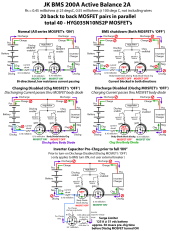@RCinFLA i may be wrong about your statement but on my benchtop observation when discharge is turned off even if i increase current over 5A and voltage drop across is 0.6 V it will not start charging ( considering cells are not fully saturated at given voltage and benchtop power supply is set same as voltage measured before JK BMS. Initial drop across BMS will result in no current flowing because voltage is less than true battery pack voltage. Raising pack voltage on benchtop power supply above 2 V than pack voltage measured it will trigger automatically switch for discharge ON and voltage difference will drop to 1-2 mV , where now if this is not something user knows it will charge pack 2 Volts higher ( I'm talking about pack Voltage here not cells voltage). Please correct me if I'm missing anything in my observations.
JK BMS issue with charging
- Thread starter Becaris
- Start date




